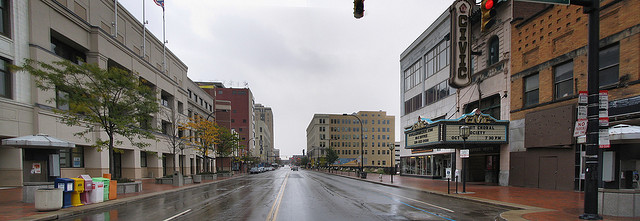
Partnering to rebuild Akron, Ohio, one block at a time
Photo of Main Street in Akron, Ohio by Flickr user Kevin T. Quinn. Jason Segedy is director of the Akron Metropolitan Area Transportation Study. Akron is one of 26 Knight communities and the birthplace of Knight Foundation.
Akron is a city with a storied past and a bright future. It’s a city navigating its way through a decades-long transition from an industrial economy to a prosperous future.
It was the fastest-growing city in the United States between 1910 and 1920, growing with the automobile and rubber and tire industries. But since the mid-’70s, we have seen heavy industry leave our city, and have lost 31 percent of our population.
The transition has been difficult, but we have many assets to build upon: strong civic leadership, a solid history of public, private and philanthropic partnerships; and a legacy of solid, well-planned neighborhoods. However, many of the houses and commercial buildings that were built during our boom years turn 100 this decade. Many of our oldest structures are increasingly blighted, vacant or abandoned.
Akron’s greatest challenge over the next few decades will be learning how to rebuild the residential and commercial structures in our neighborhoods. Our city has both the human capital as well as the innovative and collaborative culture to become a national model for learning how to do this type of work.
But we have to be intentional about it. It’s not going to happen on its own.
How do we do this? We begin by envisioning neighborhoods that are great places to live, work, play, shop, relax and socialize. Creating these types of places means being sensitive to the needs of residents, and building at a scale where people can walk and bike to where they need to go.
Doing this well will require public, philanthropic, nonprofit and private sector leadership, in partnership with everyday people working together, one block at a time, one neighborhood at a time, to rebuild their community.
Thanks to Knight Foundation, the stage is being set to do this type of work and to do it well.
In June Knight brought Jason Roberts of The Better Block to Akron for “Switching Gears,” an active transportation conference sponsored by my organization, the Akron Metropolitan Area Transportation Study. The premise of Jason’s work is to start small, with one block at a time, and to actually do something. It could be temporary new bike lanes; it could be temporary street art or street furniture; it could be a makeshift coffee shop, or art gallery or beer garden.
The important thing is to do something new in a neighborhood, let people see it, let people experience it, and, most importantly, let them participate in creating it. People build, borrow or—as a last resort—buy the materials that they need to transform their blocks. The process of working together to build something is even more important than what is physically built, because what people really build are relationships and a sense of community.
Jason was here with us again on Aug. 5 to begin an Akron pilot of the Better Block concept. At a community event that afternoon, Jason talked about the need to learn how to think small, and to implement modest, low-cost improvements that can lead to transformative changes.
Instead of simply talking about intangible future plans that will never be realized due to bureaucracy or a lack of funds, people work together to accomplish small things that they can actually see and touch. They learn to savor that first taste of success, which builds the kind of trust and inspires the type of hope that it takes to transform an entire city.
The Better Block concept isn’t a panacea. But that’s kind of the point; there is no panacea.
What it is, though, is a very powerful tool in the community development toolbox.
The Better Block recognizes that the work of rebuilding our cities begins one person at a time, one block at a time, one street at a time, one neighborhood at a time.
When coupled with visionary and innovative leadership from the public sector, the private sector, nonprofits and the philanthropic community, this approach can be truly transformative.
I am looking forward to being a part of it here in Akron—and I’ll be sure to keep you posted as it moves forward.
Recent Content
-
Communitiesarticle ·
-
Communitiesarticle ·
-
Communitiesarticle ·


